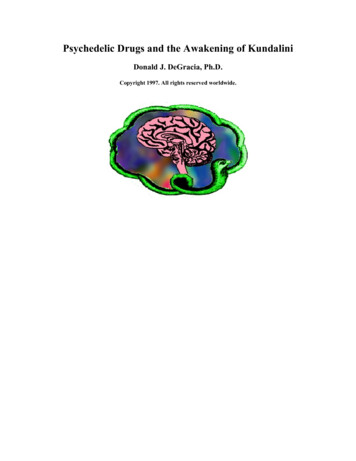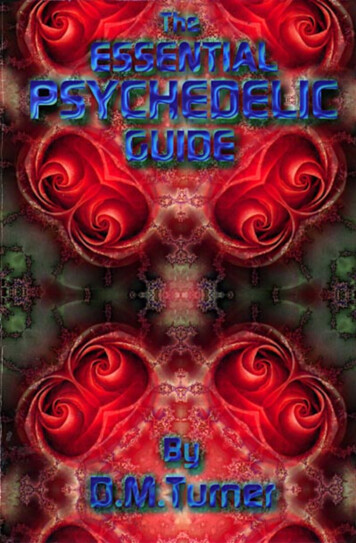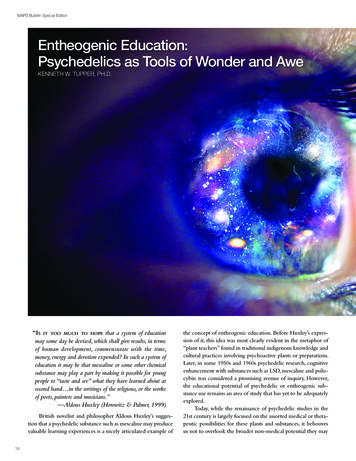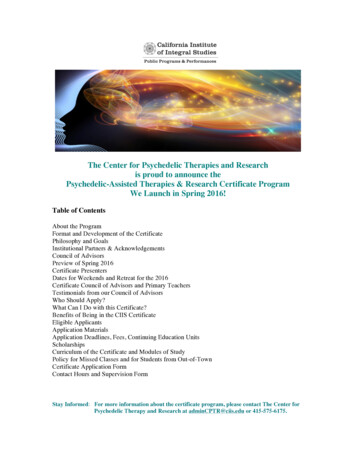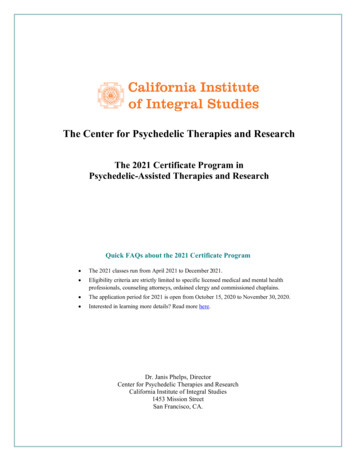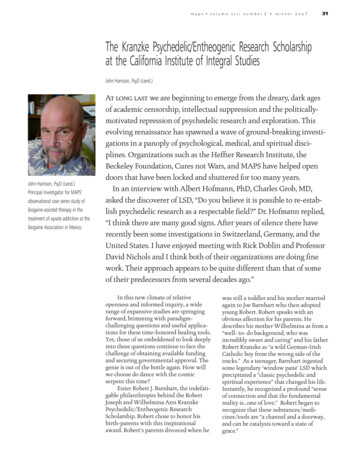
Transcription
maps volume xvii number 3 winter 2oo731The Kranzke Psychedelic/Entheogenic Research Scholarshipat the California Institute of Integral StudiesJohn Harrison, PsyD (cand.)At long last we are beginning to emerge from the dreary, dark agesof academic censorship, intellectual suppression and the politicallymotivated repression of psychedelic research and exploration. Thisevolving renaissance has spawned a wave of ground-breaking investigations in a panoply of psychological, medical, and spiritual disci-John Harrison, PsyD (cand.)Principal Investigator for MAPS’observational case series study ofibogaine-assisted therapy in thetreatment of opiate addiction at theIbogaine Association in Mexico.plines. Organizations such as the Heffter Research Institute, theBeckeley Foundation, Cures not Wars, and MAPS have helped opendoors that have been locked and shuttered for too many years.In an interview with Albert Hofmann, PhD, Charles Grob, MD,asked the discoverer of LSD, “Do you believe it is possible to re-establish psychedelic research as a respectable field?” Dr. Hofmann replied,“I think there are many good signs. After years of silence there haverecently been some investigations in Switzerland, Germany, and theUnited States. I have enjoyed meeting with Rick Doblin and ProfessorDavid Nichols and I think both of their organizations are doing finework. Their approach appears to be quite different than that of someof their predecessors from several decades ago.”In this new climate of relativeopenness and informed inquiry, a widerange of expansive studies are springingforward, brimming with paradigmchallenging questions and useful applications for these time-honored healing tools.Yet, those of us emboldened to look deeplyinto these questions continue to face thechallenge of obtaining available fundingand securing governmental approval. Thegenie is out of the bottle again. How willwe choose do dance with the cosmicserpent this time?Enter Robert J. Barnhart, the indefatigable philanthropist behind the RobertJoseph and Wilhelmina Ann KranzkePsychedelic/Entheogenic ResearchScholarship. Robert chose to honor hisbirth-parents with this inspirationalaward. Robert’s parents divorced when hewas still a toddler and his mother marriedagain to Joe Barnhart who then adoptedyoung Robert. Robert speaks with anobvious affection for his parents. Hedescribes his mother Wilhelmina as from a“well- to- do background, who wasincredibly sweet and caring” and his fatherRobert Kranzke as “a wild German-IrishCatholic boy from the wrong side of thetracks.” As a teenager, Barnhart ingestedsome legendary ‘window pane’ LSD whichprecipitated a “classic psychedelic andspiritual experience” that changed his life.Instantly, he recognized a profound “senseof connection and that the fundamentalreality is.one of love.” Robert began torecognize that these substances/medicines/tools are “a channel and a doorway,and can be catalysts toward a state ofgrace.”
32maps volume xvii number 3 winter 2oo7A friend told him about the California Institute ofpsychedelics, but what makes CIIS distinct is that weIntegral Studies (CIIS), and after extensive corresponoften look at subjects that other institutions (for whateverdence with Rick Doblin, who confirmed CIIS’ connectionsreason) may not look at as openly, but with the samewith the venerable psychedelic researchers Stan Grof anddegree of academic rigor as other centers of higherRalph Metzner, Robert decided to endow this remarkablelearning. This is why I am especially grateful to Robertscholarship at CIIS. Barnhart’s intention was (and is) forBarnhart because he has made it possible for students andthe Kranzke award to provide an opportunity, and to lendfaculty to conduct research of such a high quality.” Joeencouragement to psychedelic scholars “who are engagedadds that,, “What I love about being at this institution asin solid, rigorous research and also committed to undoingPresident (or in any capacity) is to be in a community thatthe stifling repression of the last few decades . with theis so open and so consistently strong in sustaining andintention to bring, in as broad andendorsing multiple and alternate ways of knowing.” Whatunrestricted way as possible, this fieldis salient from my discussion with Joeof study out into the open.”Subbiondo is that psychedelic/entheoIt seems natural that Robertgenic research has evolved now to theBarnhart would find a receptive homepoint that it is not only accepted andfor this scholarship at CIIS, which has aencouraged, but is actually becominglong and storied association withpart of the mainstream of academia.original thinkers, philosophers, innovaThe outstanding faculty who haveHistorically,tors and pioneers in the fields ofstepped forward as active and ardentpsychology, philosophy, spiritualmembers of the Kranzke Scholarshipacademia hasdisciplines, and consciousness research.Selection Committee also exemplifyGreat illustrious lights such as AlanCIIS’ commitment to openness. Comnot alwaysWatts, Huston Smith, Richard Tarnas,mittee Chair Frank Echenhofer, PhD, aRalph Metzner, Terence McKenna, andprofessor in the APA-accreditedbeen a receptiveStanislav Grof have been key actors inClinical Psychology program (and athe CIIS narrative. This past August, Inoted psychedelic researcher), has beenenvironment forhad the pleasure of a conversation witha mentor for several Kranzke Scholars.CIIS President Joseph Subbiondo in hisHe says that the Kranzke “is an inspirapsychedeliccomfortable office on the campus in Santion and validation for students whoFrancisco. In response to my questionshave previously been marginalized andresearch.regarding CIIS’ mind-set and setting (ifunsupported.” Dr. Echenhofer, ayou will) for the Kranzke scholarship,committee member for six years, hasPresident Subbiondo enthusiasticallywitnessed the tangible benefits thisreplied that, “Research and inquiry intoimportant award has provided for CIISpsychedelics is now (again) of intereststudents. “CIIS in general and theto scholars in higher education; it is notKranzke in particular instills a camarasomething that has to be conducted inderie in spirit with revered, highlysecret or underground. Stan Grof willrespected genuine elders in psychetell you ‘the sensationalism is over’ and we are broughtdelic/entheogenic exploration such as Grof andback to ‘can this help?’ which is a good question. We inMetzner.and this has a powerful and positive effect onhigher education are asking better questions!”students.”Historically, academia has not always been a recepSean Kelly, PhD, is a Kranzke Scholarship Committeetive environment for psychedelic research. The subjectivemember, as well as Professor and Program Director of theand unpredictable nature of this work has not commonlyPhilosophy, Cosmology, and Consciousness program atbeen a comfortable fit for the hide-bound traditional ivyCIIS. Dr. Kelly is interested in the evolution of consciouscovered walls, or the ivory tower of the entrenchedness, and he believes that “entheogens can be a bridgeeducational establishment.from modern western civilizations’ current phase ofFrom my personal experiences as a graduate studentdisenchantment with natural systems, to the traditionalin CIIS’ Clinical Psychology program, and through theworld-views that see the world as sacred, with humanpositive encouragement I have received for my dissertabeings as full participants in the sacred dance of thetion research examining the efficacy of ibogaine as acosmos.” Dr. Kelly adds that research projects such astreatment for opiate addiction, I can attest that CIISthose the Kranzke supports “can lead people to strategiesprovides an environment where there is innately lessto face and move through this critical period in humanresistance to this area of research than in most universihistory, the exploration of these non-ordinary statesties. President Subbiondo agrees, stating that this free flowmight give us access to insights and resources that mightof ideas is “not just pertaining to the subject ofnot readily be available.”
maps volume xvii number 3 winter 2oo733Janis Phelps, PhD, Professor of Clinical Psychologyin Psychiatry, Psychology and Psychotherapy: Observaand the newest member of the Kranzke Scholarshiptions from Modern Consciousness Research.” In theCommittee, explained that, “In the current era of fear andchapter, “Psychedelic Research: Past, Present, and Future,”hesitation regarding exploration of altered states ofGrof reminds us that, “In one of my early books, I sugconsciousness, there are valiant pockets of scholarlygested that the potential significance of LSD and otherresearch being conducted through institutions such aspsychedelics for psychiatry and psychology was compaMAPS, Heffter, and CIIS. The US is fortunate to have arable to the value the microscope has for biology andvisionary citizen the likes of Robert Barnhart, who hasmedicine or the telescope has for astronomy. My latersupported research on psychedelics, healing and theexperience with psychedelics only confirmed this initialtransformation of consciousness through the Kranzkeimpression. These substances function as unspecificscholarships. The Kranzke research atamplifiers that increase the cathexis (energetic charge)CIIS is being conducted by dedicatedassociated with the deep unconsciousdoctoral students whose publishedcontents of the psyche and make themdissertations disseminate entheogenavailable for conscious processing. ThisIf these entheogenicresearch data to internet sites which areunique property of psychedelics makeseasily accessible to scholars and theit possible to study psychologicaltools are, indeed,general public alike. By dispellingundercurrents that govern our experianxieties and misunderstandings aboutences and behaviors to a depth thatthe ‘keys to thethe therapeutic use of these psychoaccannot be matched by any othertive substances, research programs suchmethod and tool available in modernkingdom,’as the Kranzke have shed light onmainstream psychiatry and psycholentheogens as sacraments of emotionalogy This new knowledge couldperhaps theseand spiritual transformation.”become an integral part of a compreCIIS Professor Emeritus CIIS Ralphhensive new scientific paradigm of thededicated researchersMetzner, PhD, is a former member oftwenty-first century.” Grof adds thatthe Kranzke committee. He says that,what is most encouraging is thatare actually modern“The Kranzke sccholarships at CIIS .“researchers of the younger generationare to my knowledge unique in higherin the United States, Switzerland, andpsychonaut-locksmithseducation, in their explicit focus onother countries have in recent yearsfurthering research with consciousbeen able to obtain official permissionopening the vaultsness-expanding plants and substances.to start programs of psychedelicSince the practices involved are often oftherapy, involving LSD, psilocybin,to previously hiddenquestionable legal status, CIIS studentsdimethyltryptamine (DMT),are obviously unable to administer nces. However, nothing prevents(MMDA), ibogaine, and ketamine. Igraduate students from studying thehope that this is the beginning of ause of psychedelic or entheogenicrenaissance of interest in psychedelicplants by various people, as well asresearch that will eventually returnother catalysts for heightened states of awareness, as longthese extraordinary tools into the hands of responsibleas the usual legal and ethical guidelines for research withtherapists.”human subjects are observed.”To facilitate the continuation of this renaissance,The raison d’etre of the Kranzke award is, of course,Robert Barnhart has taken steps to ensure that thethe research itself. We have selected six abstracts andKranzke Psychedelic/Entheogenic Research Scholarshipsummaries from a few of the Kranzke scholars that expresswill be endowed and continue in perpetuity at CIIS. I amonly a wee bit of the infinite potential and the universalconfident that I speak for all entheogenic researchers,curiosity about what Hegel, or more recently the late,audacious psychonauts, past and future winners of thegreat Terence McKenna might call, ‘the Other.’ If theseKranzke Scholarship, and the entire MAPS community inentheogenic tools are, indeed, the ‘keys to the kingdom,’expressing our deep gratitude to Robert J. Barnhart for hisperhaps these dedicated researchers are actually modernheartfelt generosity, and his oracular vision! Robert psychonaut-locksmiths opening the vaults to previouslyThank You!hidden treasures. Perhaps reading about these exploraSo, dear reader, take a few minutes and read thesetions will inspire the next wave of researchers to growresearch summaries. I think you will be impressed withinto a tsunami of entheogenic psychedelic seekers andthe diversity of interests, the skillful and professionalscientists!scientific method, and the researchers’ obvious devotionStanislav Grof, MD, discusses the importance of thisto, and concern for, their invaluable subjects. Enjoy!work in his latest collection of papers, “New Perspectives
34maps volume xvii number 3 winter 2oo7Guided and Structured Use of EntheogenicSubstances in Western Culture.Roger Marsden, PhDClinical Psychology (2002)For my doctoral dissertation inthe clinical psychology program at CIISI looked at therapeutic psycho-spiritualissues in guided, group settings (whatMetzner has called “hybrid shamanicpsychotherapeutic rituals”) utilizingpsychedelic substances. These groups arehybrid in that they incorporate someshamanic or indigenous techniques witha western psychological orientation.My interest in these groups beganwith my work with Pablo, the guide in oneof the groups analyzed in my dissertation.Pablo’s work was an adaptation of theearlier work of Mexican psychiatristSalvadore Roquette. (Roquette had apsychiatric background and incorporatedthe indigenous teachings of MazotecIndian healer Maria Sabina.) I was alwaysinterested in the development of thevarying approaches of different groups aswell as the implications for results.My interest was further piqued by thefact that because these groups are underground, research had been minimal tonon-existent since the 1960s. There hasbeen sizable literature on the psychedelicexperience, but other than the cut-shortresearch in the 1960s, most of it has beenpersonal, theoretical and anecdotal.My research reiterated and developedsome familiar points such as the importance of preparation, integration, and thecomplex dynamics of the relationshipsbetween participants and guides, etc., aswell as some less familiar themes thatpoint toward future research questions,such as: what is the psycho-spiritual andtherapeutic difference in the impact of onemedicine from another, the relationship ofecstatic or transpersonal experiences tothe psychological. Another importantfocus was the relationship of the psychedelic experience to work with addictions.With the support and encouragementof a school like the California Institute ofIntegral Studies in combination with thefinancial support of Robert Barnhart’sgenerous gift of the Kranzke endowment,the psychedelic experience has, since1998, been regularly researched at thegraduate level. Thanks to CIIS and Mr.Barnhart’s creative and generous idea,there is now a significant and growingbody of psychedelic research residing inone place. (Roger has a chapter, co-written withDavid Lukoff, in the new two volume set,Psychedelic Medicine, edited by Winklemanand Effects of Calea Sacatechichi on the HumanElectroencephalogram: A Single SubjectDesign EEG Gamma Coherence and OtherCorrelates of Subjective Reports DuringAyahuasca ExperiencesDavid Stuckey, PsyDClinical PsychologyI was supported by the Kranzkeresearch scholarship twice; once for aproject studying the effects of caleazacatechichi, and the second for mydissertation research with ayahuasca.The scholarships were very important inallowing me to move forward with theresearch I was doing with Dr. FrankEchenhofer at CIIS. Brainwave (EEG)research requires a lot of lab equipmentand supplies that would have beenprohibitive without this type offinancial support.I began with an interest in researching visual imagery and lucid dreaming. Icame to understand how difficult it was tolucid dream on command in a laboratorysetting. At the time, I did not have theavailable connections with expert dreamers who could be flown in for such anundertaking. I decided to get some help inthe task of inducing lucidity by usingshamanic dream-inducing (oneirogenic)herbs. Calea zacatechichi was chosen. Itwas at that time that we came to understand that the Kranzke scholarship wasavailable to support such work, since ourinterest included the assistance of anentheogen.As it turned out, the calea research didnot prove fruitful and it was thereforedecided to move into researching a much
maps volume xvii number 3 winter 2oo7stronger imagery experience that could beinduced using psychedelic substances. Iwas also becoming fascinated with thesubjective reports of people using ayahuasca and intrigued by the comparison of theayahuasca journey with lucid dreaming.The Kranzke scholarship then supportedmy research with ayahuasca, whichbecame my dissertation work and waslater published in an abbreviated form inthe Journal of Psychoactive Drugs. Theabstract from the journal article and thecalea research are posted on the MAPSWebsite: maps.org/stuckeyabstractsThe scholarship also sparked furthergood fortune, in that by receiving it, theCIIS administration became aware of theproject and made a further financialcontribution. MAPS contributed financialsupport as well. With this combinedsupport, we were able to take the projectto the Amazon jungle for proper fieldresearch. I was very grateful for thegenerous support and continue to begrateful that the Kranzke scholarship isavailable for current students.I am now in private practice as aclinical psychologist in Southern California. I use what I have learned through myuse and research with psychedelics andlucid dreaming to inform my work withmy clients. I also continue to do EEGresearch with entheogens. For example, Ijust recently led a panel at the annualconference of the International Society forNeurofeedback and Research. We presented our pilot research on EEG findingsand subjective reports of salvia divinorumexperiences. eœoeœoeœoeoeœoeœoeœoeoeœoeœoeœoeTouched By Spirit: A Heuristic Study ofHealing Experiences in Peyote CeremoniesThis dissertation is a qualitative,psychological investigation exploring theexperience of healing in peyote ceremonies using Moustakas’ (1990) heuristicresearch methodology. The uniquecontribution of this research project is theuse of a psychological approach to thestudy of peyote ceremonies that honorspeople’s subjective experience. This studydraws on interview data collected fromnine participants of peyote ceremonies.The co-researchers were five men and fourwomen in the age range between their latetwenties and early sixties. Five of the coresearchers were Euro-Americans, threeNative Americans and one mixed EuroNative American.The data analysis resulted in theidentification of seven core themes of theexperience of healing in peyote ceremonies. These were: spiritual connection;enhanced self-esteem; emotional release,sense of community; physical recovery andsupport; insight and heightened awareness; and enhanced environmentalsensitivity. Participants in peyote ceremonies reported becoming aware of a deeperspiritual reality within as well as aroundthem. The peyote ceremonies instilled inthem a sense of sacredness and reverencefor life. They also reported increasedmental clarity and a sense of heightenedawareness. On the emotional level theyreported the release of repressed feelings,a new level of self-acceptance and heightened self-esteem. They stressed theimportance of the experience of solidarityand fellowship, of love, unity and belonging in the circle. Participants in peyoteceremonies also reported sudden cures ofdiseases and physical ailments, as well asbeing able to overcome drug and alcoholaddiction. They also reported an increasedawareness of their connection to thenatural world and an increased environmental concern as a result of their participation in peyote ceremonies.By providing accurate accounts ofhealing experiences and in-depth portrayals of individual cases this study aspires tocontribute to a better understanding of thetherapeutic potential of peyote ceremoniesand the religious use of entheogens ingeneral. It is the primary researcher’s hopeto thereby stimulate a renewed dialogueon the constructive use of entheogens incontemporary society. Christian Dombrowe, PhD35
36maps volume xvii number 3 winter 2oo7The Healing Power of the Icaros:A Phenomenological StudySusana Bustos PhD (cand.)East-West PsychologyThe focus of this study is to explorethe phenomenon of the healing with anicaro during an ayahuasca ceremony in thetradition of Peruvian mestizo vegetalismo,as well as to identify key aspects of themusical perception to which healingmeanings are attributed.Participants in this study are five menand women with extensive experiencewith brew in this context, each of whomwas able to identify the icaro in therecording of the ceremony where thephenomenon emerged. The data collectionprocedures include a written report of theexperience, and two in-depth interviews.The analysis employs the method ofDescriptive Phenomenology for Psychology, as developed by Giorgi (1985; 1987;1997; 1998; 2000).Ten months of fieldwork in the areasof Tarapoto and Pucallpa were required tocollect the data. Thirty-seven ceremonieswere sound-recorded, with a total of 239attendees. The emergence of the phenomenon was charted within the demographicparameters of sex and age. A formalmusical analysis of the icaros identified byparticipants is included in the study ascomplimentary data. Additional datacollected during the fieldwork include 120hours of recordings of icaros sung bydifferent ayahuasqueros, and in-depthinterviews of six of them on their perspectives of how the icaros heal.The study is expected to be completedby December 2007. While I originallyplanned for six months of field work, itended up being ten months of intensiveresearch, personal challenge, and a firsthand understanding of this tradition-bothits social context and cosmology. Thefinancial support of the Kranzke grant wasinvaluable in allowing the completion ofthat stage, as well as opening compellingresearch possibilities beyond this study. Susana Bustos is a clinical psychologistand music therapist from Chile. Her work ondrug abuse and on the therapeutic aspects ofexpanded states of consciousness dovetailedwith her passion for music and song during herfirst journey to the Peruvian Amazon in 1989,where she experienced an icaro sung by RoseGiove, one of the founders of The Ayahuasquero and Personality: A StudyKirby Surprise, PsyDClinical PsychologyThe Kranzke scholarship wasinstrumental in helping complete mystudy of the personality traits and characteristics of frequent ayahuasca drinkers inNorth America. This research used themost accepted and validated of thepersonality assessments, the MMPI andMMPI-2. This research built on previousfindings on personality done with smaller,less-known measures of personalityconducted with frequent drinkers ofayahuasca done in South America withinthe Uni De Vegetal (UDV), the first andlargest of the religions that have formedtheir own communities centered on theuse of ayahuasca. By studying a NorthAmerican population that was not livingwithin or closely tied to participation in areligious community, it was hoped that aclearer view of the personalities ofayahuasca drinkers outside of thesereligious and cultural settings could becreated.Thirty-four frequent North Americandrinkers of ayahuasca were administeredthe Minnesota Multiphasic PersonalityInventory (MMPI-2). The MMPI personality description for the group was withinnormal limits of personality. The responses of the ayahuasca drinkers werenot found to have a high correlation withthe scores of drug and alcohol abusers. Allscores, with the exception of low aggression, were within normal ranges ofpersonality. No overall difference betweenthe high and low use groups was found.The study found personality traits ofNorth American ayahuasca drinkers to bewithin normal limits of personality. Thestudy strongly suggests that frequentdrinking of ayahuasca in the NorthAmerican population has produced no
maps volume xvii number 3 winter 2oo7effects on their personalities of clinicalconcern.I started this project in an attempt togive something back to a field that I hadfound to be instrumental to the healing ofmany people. I felt that to be able to addone small piece of solid research information to what was known about ayahuascawould be a way of giving something backto the community that could be built on byothers in the continuing effort to evaluatethe effects and healing potential ofayahuasca. At the time the Kranzkescholarship award notice arrived, mydissertation chair and I had discoveredthat instead of working with just 10 mainscales of the MMPI-2, we were probablygoing to have to expand the study to 123scales. At the time I was hand-scoring thetests, and had spent weeks on these 10scales, and now I was faced with handscoring and calculating over thirty-fivethousand data points. The scholarshipallowed all participants’ responses to besent for computerized scoring and extended analysis by the developer of theMMPI-2, saving many hundreds of hoursof labor, and producing clean, error-freedata. The money paid for the statisticalsoftware used to analyze the data, creategraphical displays, and make it understandable and presentable. When ourmain computer was hit by a virus thatmade it unusable, we were able to replaceit, restore the data and move forward. Thescholarship paid for paper, printer cartridges, stamps, an editor and filing feesfor the completed dissertation.The Kranzke scholarship allowed thisresearch project to move forward throughdelays and setbacks that, although normalto the research process, often mean manyprojects are not completed or fully developed. The scholarship helped give me theability to contribute something back to thecommunity, and it is my hope that thisspirit of gratitude and generosity maycontinue. ical Variables PredictingTransformative and Difficult UnresolvedAyahuasca Experiences: A Pilot StudyThis pilot study aims to explore apossible connection between distinctpsychological variables and subjectivereports or themes experienced duringshamanic ayahuasca journeys. WhileWesterners report ayahuasca elicitsintegrative experiences for journeyers,some re-traumatization occurs in aminority of cases. This investigationattempts to identify a psychometricallysound and reliable method for predictingthe quality of the experiences people mayhave on ayahuasca and possibly otherkinds of hallucinogenic drugs used inhealing or experimental settings. Thenatural extension of this work is in thearea of harm reduction. Investigation intothe mysteries of psychedelic/entheogenicplants and substances has enjoyed atenuous resurgence in recent years.Developing a clinically valid and reliablemethod for predicting a participant’sreaction to a psychedelic substance haspotentially vast implications for theacceptance and proliferation of researchwith these substances.I am truly honored to be a 2007recipient of the Krankze Scholarship. Atthe awards banquet I was afforded anopportunity to speak briefly about thescholarship and what it means to youngresearchers and the field of psychedelicstudies. This money represents commitment that grassroots supporters likeRobert Barnhart have to the cause ofpsychedelic research. Though organizations like MAPS have made importantcontributions in the public arena, it isreally the people behind the scenes, withtheir courage and tenacity, who despiteoverwhelming odds continue to championthe use of entheogens as importantmethods of healing.In person, Robert Barnhart is a kindand thoughtful man whose easy-goingnature belies the impact he has had on myresearch and that of other Kranzkewinners past and present. He allows thesum of our efforts to be greater than theindividual parts. John Burton PsyD (cand.)Clinical Psychology37
the CIIS narrative. This past August, I had the pleasure of a conversation with CIIS President Joseph Subbiondo in his comfortable office on the campus in San Francisco. In response to my questions regarding CIIS' mind-set and setting (if you will) for the Kranzke scholarship, President Subbiondo enthusiastically replied that, "Research and .


